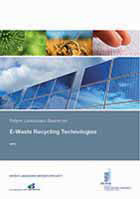Patent Landscape Report on E-Waste Recycling Technologies
Publication year: 2013
DOI: English

The report covers in detail patent applications and granted patents within the space of e-waste processing, and the recycling and recovery of materials from consumer products at the end of their useful life. Additionally, the report uses reference information, such as news and other business data sources to extend the information into real-world applicability, and also to verify the interest and commercial activity of entities mentioned within the study.
- Topic: Climate Change / Energy
- Cooperation partners: UNEP; Secretariat of the Basel Convention (SBC)
This report was prepared in the context of collaboration of WIPO with the Secretariat of the Basel Convention on the Control of Transboundary Movements of Hazardous Wastes and their Disposal (SBC), which is administered by the United Nations Environment Programme (UNEP).
The report aims at providing patent based evidence on the available technologies and the patenting trends in the area of electronic waste (E-waste) recycling and material recovery, while it is intended to provide background and supporting information to the Partnership for Action on Computing Equipment under the Basel Convention and complement the Guideline on Material Recovery and Recycling of End-of-Life Mobile Phones and the Guideline on Environmentally Sound Material Recovery and Recycling of End-of-Life Computing Equipment.
The report covers in detail patent applications and granted patents within the space of e-waste processing, and the recycling and recovery of materials from consumer products at the end of their useful life. Additionally, the report uses reference information, such as news and other business data sources to extend the information into real-world applicability, and also to verify the interest and commercial activity of entities mentioned within the study.
The patent landscaping process applied to the e-waste field has uncovered several interesting facets of the electronic waste industry. Specifically, the patent activity of global E-waste innovation points strongly to the commoditization of electronic waste; in particular, as a source of high value materials, such as rare earth metals (e.g. lanthanum, neodymium and praseodymium) that are commonly used in modern electronic items. A similar trend is also shown for noble metals, in particular silver, but also gold and platinum. Overall, patent activity within e-waste mirrors the rate of growth exhibited by relevant mentions in the media, confirming that growing economic interest in dealing with end-of-life electronics is occurring alongside and spurring on global innovators.